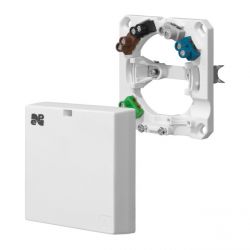FAQ
TL;DR: Use a flexible H07RN‑F cable and size for approx. 70°C service; “the usual one has the right operating temperature (70°C).” Keep oven and hob on separate circuits unless the unit is designed otherwise. [Elektroda, icosie, post #16970601]
Why it matters: This prevents overheated wiring, nuisance trips, and costly rework when replacing or upgrading appliances.
Who this is for: DIYers and installers wiring an induction hob above an oven, choosing cable type, size, connectors, and protection.
Quick Facts
- Standard practice: connect hobs with a flexible cable (e.g., H07RN‑F), not rigid building wire. [Elektroda, zein, post #16970618]
- Typical section: 5×2.5 mm² from wall to hob; avoid 4‑core if future upgrades are likely. [Elektroda, icosie, post #16970601]
- Temperature: PVC flex rated around 70 °C is adequate behind an oven-hob stack. [Elektroda, icosie, post #16970601]
- Load example: 7.4 kW hob; some models call for 32 A protection at 230 V. [Elektroda, Mrozan, post #16972279]
- Circuits: Hob and oven are separate loads; use separate circuits unless it’s a combined unit. [Elektroda, kkas12, post #16970713]
What wire type should I use between the junction box and an induction hob?
Use a flexible cable, such as H07RN‑F. Standards and installers favor flexible cords for appliance connections because they tolerate movement and routing behind cabinets. Buy from a wholesaler rather than a big-box store for better availability and pricing. [Elektroda, zein, post #16970618]
Is 5×2.5 mm² or 4×2.5 mm² enough for an induction hob?
Run a 5×2.5 mm² flexible cable to the hob. It covers typical multi‑phase hookup and simplifies future replacements. Using 4‑core limits options if you change appliances later, forcing a re-cable. “It does not make sense to use 4×2.5 mm².” [Elektroda, icosie, post #16970601]
Will heat from an oven under the hob damage the cable?
No. Behind a properly installed oven and hob, temperatures remain below typical cable ratings. Experienced installers report it “will not be dangerously high.” Route the flex cleanly between the units and avoid direct contact with hot surfaces. [Elektroda, mawerix123, post #16971643]
Can I power the oven from the spare phase feeding a two‑phase hob?
Treat hob and oven as two separate receivers on two separate circuits. Only combined factory‑designed units may share phases internally. Otherwise, do not repurpose a free phase from the hob feed for the oven. [Elektroda, kkas12, post #16970713]
Do I need an RCD/GFCI if I hardwire the hob?
In TN systems, a hardwired connection does not mandate an RCD. In TT systems, use RCD protection. Follow your local supply system rules and manufacturer instructions. When unsure, consult a licensed electrician. [Elektroda, kkas12, post #16970713]
What current should I expect per phase on a multi‑phase hob?
Designs keep each phase at or below about 16 A. A 3‑phase connection spreads load so any phase stays within that current, aiding breaker coordination and cable sizing. [Elektroda, MARCIN.SLASK, post #16970980]
Are WAGO (spring) connectors OK for hob connections?
They can be used, and several installers report success. If you choose them, select the correct series and rating, and mount inside an enclosure rated for the location. “Wago is also ok.” [Elektroda, zein, post #16972293]
When should I avoid spring connectors and use a screw terminal strip instead?
For higher currents and heat-prone areas, prefer a solid screw terminal strip and crimped ferrules for strong, low-resistance joints. Poor contacts cause overheating and failures. “Here you have high currents and the proper contact of the connection must be.” [Elektroda, MARCIN.SLASK, post #16972627]
What is H07RN‑F cable?
It’s a heavy‑duty, flexible rubber‑sheathed cable suited for appliances. Installers favor it for durability, flexibility behind cabinets, and robust insulation. It routes neatly and avoids the stiffness of rigid YDY building wire. [Elektroda, MARCIN.SLASK, post #16970599]
How do I hardwire an induction hob with a junction box?
- Install a dedicated hob junction box with integrated clamps and cord strain relief.
- Terminate the flexible cable with crimp ferrules and connect L/N/PE to the internal clamps.
- Secure the cord in the holder, close the box, and connect the hob per its diagram. [Elektroda, Łukasz-O, post #16972646]
Should I use a socket or hardwire the hob?
Hardwire directly to the supply using a flexible cable and an appropriate junction box. Many hobs are intended for direct connection without a plug-and-socket interface, reducing weak points. [Elektroda, icosie, post #16970601]
What breaker size does a 7.4 kW, 230 V hob need?
Follow the nameplate. For the cited Amica 7.4 kW model, the manufacturer requires 32 A protection at 230 V. Always match the wiring diagram that comes with the appliance. [Elektroda, Mrozan, post #16972279]
Do new hobs and ovens include a power cord from the factory?
Many modern appliances arrive with a fitted power cord. If a cord or plug is not supplied, do not add one unless the manufacturer permits it. [Elektroda, kkas12, post #16970713]
How should I route and secure the protective earth (PE) conductor?
Make the PE conductor slightly longer in both the junction box and the appliance cavity. If tension pulls on the cable, PE stays connected last, preserving earthing until the end. [Elektroda, kkas12, post #16972408]
What if my wall feed is only 4×1.5 mm² from a previous install?
Do not reuse undersized circuits. High current loads need adequate section and secure terminations. Upgrade the circuit and use a quality terminal strip and ferrules to avoid overheating. [Elektroda, MARCIN.SLASK, post #16972627]
Is hiring a licensed electrician worth it for this job?
Yes. A licensed electrician can supply the correct cable, conceal routing, and provide a workmanship guarantee at modest cost, saving time and risk. [Elektroda, Mrozan, post #17004536]



